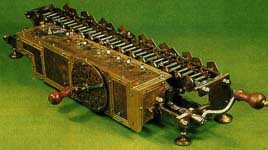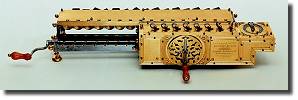
Gottfried Wilhem von Leibniz

1646-1716
Friedrich Leibniz, a professor of moral philosophy at Leipzig (now part of
Germany) and Catharina Schmuck (his third wife) had a child, Gottfried Wilhem,
in July 1646. Friedrich was by all accounts a loving and dedicated father
who died when Gottfried Wilhem was only six. Leibniz's mother raised him
thereafter. Leibniz entered the Nicolai School in Leipzig when he was
seven. He seemed to be a motivated and gifted pupil. He entered the University of
Leipzig at the age of 14, a tender but not unheard of age at the time. He graduated
from the University of Leipzig in 1663. His thesis was De Principio Individui (On the Principle of the Individual).
During the following summer in Jena, Leibniz the mathematician and philosopher Erhard Weigel
who had a significant influence on Leibniz's thought. October 1663 found Leibniz
back in Leipzig working towards a doctorate in law. He was awarded his Master's Degree in philosophy
at the age of 18 in 1664 for a dissertation
relating philosophy and law to various ideas in mathematics. Catharina
passed on mere days after Leibniz presented his dissertation. The next
step for a European academician is to complete their habilitation. Leibniz completed Dissertatio de arte combinatoria (Dissertation on the combinatorial
art) to complete his habilitation in 1666. This work is strongly reductionist in that it attempts account for
reasoning and discovery in terms of such basic items as numbers, sounds, and
colors.
For reasons that remain somewhat unclear, the University of Leipzig denied
Leibniz his doctorate in law. Some of the possible explanations include
political intrigue and his young age combined with the limited number of
tutorships. Leibniz instead moved to the University of Altdorf, receiving a doctorate in law in February 1667
upon completion of De Casibus Perplexis (On Perplexing Cases).
Altdorf offered Leibniz a chair, but he declined preferring to enter into the
service of Nuremburg alchemical society a as its secretary and later entering
the employ of his friend Baron Johann Christian von Boineburg as a secretary, assistant, librarian, lawyer and
advisori. By 1670 Leibniz was also involved in improving the civil code
for Mainz. In 1671 he also published Hypothesis Physica Nova (New Physical
Hypothesis).
1672 found Leibniz in Paris studying mathematics with Christiaan Huygens and
on a mission for Boineburg to influence Louis XIV in ways that would keep the
king from attacking German territories. During this time he made some
contributions to summing series while reading Saint-Vincent on that subject.
Leibniz went to England with Boineburg's nephew on another peace mission.
While in England he demonstrated his incomplete calculating machine for the
Royal society. He was not well-recieved. Pell informed him that his
results on series turned out to have been in a book by Mouton. Hook also
made some disparaging remarks regarding Leibniz's calculator.
Nevertheless, he was elected a fellow of the Royal Society in 1673.
From 1673 to 1675 Leibniz worked on what would become his calculus. He
first adopted the notation we use today [f(x)dx] in 1675. Newton and
Leibniz exchanged letters regarding the calculus, but delays and
miscommunications made their interactions less useful to one another as they
might have been. Newton ultimately believed that Leibniz had stolen his
methods. History has shown that Leibniz developed the ideas independently
and that Leibniz's formalism, which included the integral sign and the
derivative notation proved useful in subsequent work.
From 1676 until his death in 1716 Leibniz lived in Hannover, at first as the librarian and Court Councilor for Duke Johann Friedrich. Nevertheless, he traveled widely. In 1684 Leibniz published On a New Method for Maxima and Minima his first publication outlining his work on the calculus. Leibniz published Meditationes de Cognitione, Veritate et Ideis (Reflections on Knowledge, Truth, and Ideas) which clarified his theory of knowledge. In 1686-7 Leibniz wrote his Discours de Métaphysique (Discourse on Metaphysics) which was not published until 1846. Leibniz developed a system of binary mathematics which he published in 1701. Leibniz wrote Essais de Théodicée (Essays on Theodicy) and dedicated it to his close friend Sophie Charlotte (the cousin of Duke Johann Friedrich) who died in 1705. It was published in 1710. Leibniz's claim in this work that ours was the best of all possible worlds inspired Voiltiare's Candide. La Monadologie (The Monadology) was written in 1714-1715 but not published until 1720.
Leibniz died at the age of seventy in 1716. Arthritis and goat troubled his later years and he was buried properly but with only one mourner, his assistant.
 |
Leibniz Wheel |

Replicas of the Stepped Reckoner |

More Elaborate Drawing of the Mechanism |
Links
| G. W. LEIBNIZ - an Universal Philosopher
|
Donald
Rutherford Site
|
Mactutor
Biography
|
| Leibniz-Arnauld Correspondence Page | Gregory Brown's Liebnitiana |